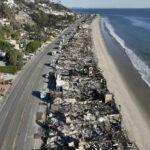New York and Boston experienced a record number of days with coastal flooding in the last year as waters surged time and again more than 1 foot (31 centimeters) above normal high tide levels.
New York had 15 record flood days from May 2017 to April 2018, and Boston had 22, according to a report Wednesday from the U.S. Center for Operational Oceanographic Products and Services. The Northeast could be swamped for 5 to 6 days in the coming year, the center forecasts.
“What was fairly uncommon before has become common,” Gregory Dusek, chief scientist at the center in Silver Spring, Maryland, said in a conference call with reporters.
Coastal floods are growing more frequent because oceans are rising beyond traditional limits, swamping streets, sewer systems and causing billions in damages to real estate. The Northeast — with more than $5 trillion in coastal property from New York to Massachusetts — is getting hit particularly hard because winter storms are exacerbating effects of global warming, driving sea levels even higher. In January and March, nor’easters drove tides in Boston Harbor, home to the Everett liquefied natural gas terminal, to their two highest levels ever.
About one third of sea level rise stems from the thermal expansion of the ocean due to higher temperatures, Dusek said. Two thirds, he said, can be blamed on ice melting in Greenland, Antarctica and elsewhere. The U.S. had its warmest May on record for the contiguous 48 states, the National Oceanic and Atmospheric Administration said in a separate statement.
Other areas that experienced record tidal flooding include Sabine Pass, Texas, which is home to a liquefied natural gas export terminal and had 23 record days. Galveston — at the mouth of the Houston ship channel — had 18 days. And San Diego, California, had 13.




















 Don’t Forget Workers Comp Tariff Impacts: Berkley
Don’t Forget Workers Comp Tariff Impacts: Berkley  Lawsuits Accuse Insurers of Colluding to Drop Coverage in Fire-Prone Areas of California
Lawsuits Accuse Insurers of Colluding to Drop Coverage in Fire-Prone Areas of California  Beyond Automation: How GenAI Informs Next Best Action in P/C Insurance Claims and Underwriting
Beyond Automation: How GenAI Informs Next Best Action in P/C Insurance Claims and Underwriting  U.S. Excess & Surplus Lines Boost London Market Top-Line Growth
U.S. Excess & Surplus Lines Boost London Market Top-Line Growth 






